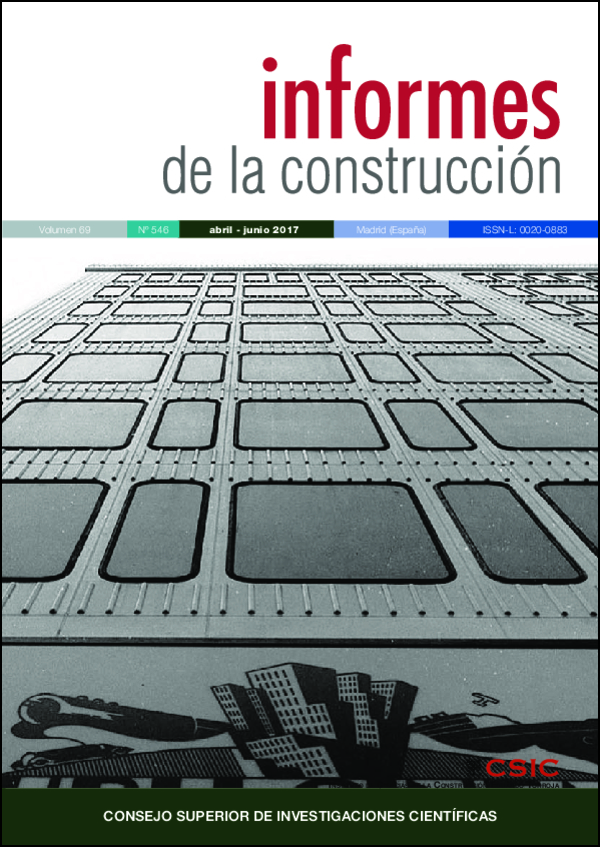Bayesian analysis of risk associated with workplace accidents in earthmoving operations
DOI:
https://doi.org/10.3989/ic.15.154Keywords:
civil works, earthmoving, safety management, risk assessment, Bayesian networks, data miningAbstract
This paper analyses the characteristics of earthmoving operations involving a workplace accident. Bayesian networks were used to identify the factors that best predicted potential risk situations. Inference studies were then conducted to analyse the interplay between different risk factors. We demonstrate the potential of Bayesian networks to describe workplace contexts and predict risk situations from a safety and production planning perspective.
Downloads
References
(1) Swuste, P., Frijters, A., Guldenmund, F. (2012). Is it possible to influence safety in the building sector? A literature review extending from 1980 until the present. Safety Science, 50(5): 1333-1343. https://doi.org/10.1016/j.ssci.2011.12.036
(2) Feng, Y., Zhang, S., Wu, P. (2015). Factors influencing workplace accident costs of building projects. Safety Science, 72: 97-104. https://doi.org/10.1016/j.ssci.2014.08.008
(3) Holte, K. A., Kjestveit, K., Lipscomb, H. J. (2015). Company size and differences in injury prevalence among apprentices in building and construction in Norway. Safety Science, 71: 205-212. https://doi.org/10.1016/j.ssci.2014.01.007
(4) Lee, H. S., Kim, H., Park, M., Ai Lin Teo, E., Lee, K. P. (2012). Construction risk assessment using site influence factors. Journal of Computing in Civil Engineering, 26(3): 319-330. https://doi.org/10.1061/(ASCE)CP.1943-5487.0000146
(5) Park, J., Park, S., Oh, T. (2015). The development of a web-based construction safety management information system to improve risk assessment. Journal of Civil Engineering, 19(3): 528-537. https://doi.org/10.1007/s12205-014-0664-2
(6) Neapolitan, R. E. (2004). Learning Bayesian networks. Prentice Hall.
(7) Rivas, T., Matías, J. M., Taboada, J., Argüelles, A. (2007). Application of Bayesian networks to the evaluation of roofing slate quality. Engineering Geology, 94: 27-37. https://doi.org/10.1016/j.enggeo.2007.06.002
(8) Martín, J. E., Rivas, T., Matías, J. M., Taboada, J., Argüelles, A. (2009). A Bayesian network analysis of workplace accidents caused by falls from a height. Safety Science, 47: 206-214. https://doi.org/10.1016/j.ssci.2008.03.004
(9) Li, L., Wang, J., Leung, H., Jiang, C. (2010). Assessment of Catastrophic Risk Using Bayesian Network Constructed from Domain Knowledge and Spatial Data. Risk Analysis: An International Journal, 30(7): 1157-1175.
(10) Rivas, T., Paz, M., Martín, J. E., Matías, J. M., García, J. F., Taboada, J. (2011). Explaining and predicting workplace accidents using data-mining techniques. Reliability Engineering and System Safety, 96: 739-747. https://doi.org/10.1016/j.ress.2011.03.006
(11) Leu, S. S., Chang, C. M. (2013). Bayesian-network-based safety risk assessment for steel construction projects. Accident Analysis and Prevention, 54: 122-123. https://doi.org/10.1016/j.aap.2013.02.019 PMid:23499984
(12) GeNIe & SMILE (2015). Structural Modeling, Inference, and Learning Engine. Decision Systems Laboratory, University of Pittsburgh, https://www.bayesfusion.com/.
Published
How to Cite
Issue
Section
License
Copyright (c) 2017 Consejo Superior de Investigaciones Científicas (CSIC)

This work is licensed under a Creative Commons Attribution 4.0 International License.
© CSIC. Manuscripts published in both the print and online versions of this journal are the property of the Consejo Superior de Investigaciones Científicas, and quoting this source is a requirement for any partial or full reproduction.
All contents of this electronic edition, except where otherwise noted, are distributed under a Creative Commons Attribution 4.0 International (CC BY 4.0) licence. You may read the basic information and the legal text of the licence. The indication of the CC BY 4.0 licence must be expressly stated in this way when necessary.
Self-archiving in repositories, personal webpages or similar, of any version other than the final version of the work produced by the publisher, is not allowed.















